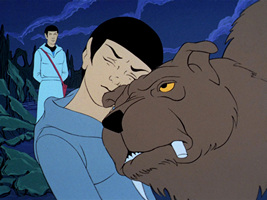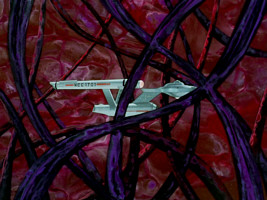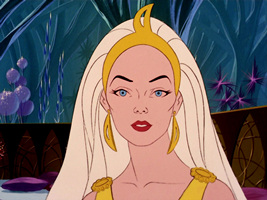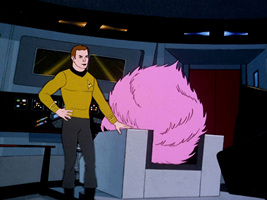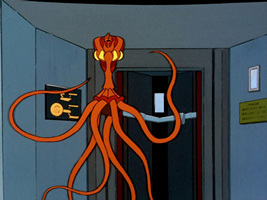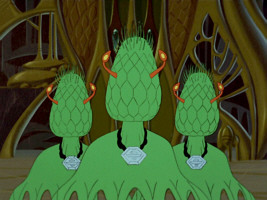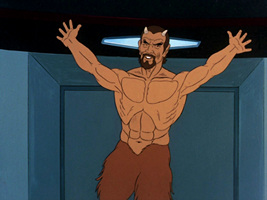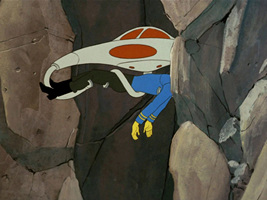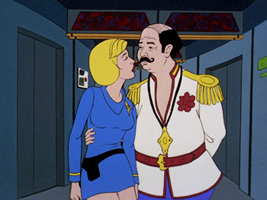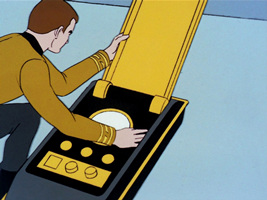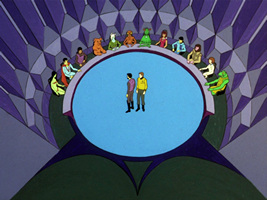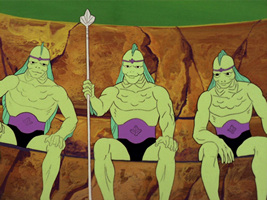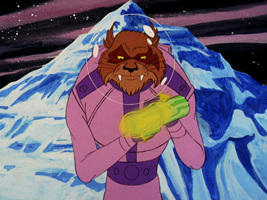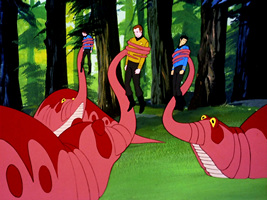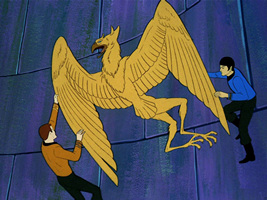The Animated Series (TAS) Season 1
Season 1Season 2
Beyond the Farthest StarYesteryearOne of Our Planets Is MissingThe Lorelei Signal
More Tribbles, More TroublesThe SurvivorThe Infinite VulcanThe Magicks of Megas-Tu
Once Upon a PlanetMudd's PassionThe Terratin IncidentThe Time Trap
The Ambergris ElementThe Slaver WeaponThe Eye of the BeholderThe Jihad
Beyond the Farthest Star
Synopsis
Stardate 5521.3: The Enterprise is dragged off course by Questar M-17, an imploded star. In orbit around Questar an ancient starship is discovered, inhabited by a shapeless alien. Further investigation reveals that the ship's engineers had failed to remove the creature before attempting to destroy their own vessel. When the creature takes control of the Enterprise, Kirk and Spock steer the Enterprise toward Questar M-17, tricking the creature into believing that the ship will be destroyed. Actually, through the slingshot effect, the Enterprise frees itself from the gravity pull, leaving the creature to orbit forever around the star.
Commentary
Although the episode is fairly entertaining, it remains predictable and never gets really exciting. One of the reasons is that we have seen so many "evil" alien entities like this one already in TOS. The alien pod ship is a nifty concept, and showing the landing party in its spacious interior is something that could not have been done with real sets and actors, at least not in the late 60s. The control room looked quite conventional though. It should have been more "alien", in view of the exotic outer appearance of the pod ship. The slingshot effect (mentioned in TOS: "Assignment: Earth" thus far) creates nice continuity.
Annotations
- Remarkable error: Spock says that the "temperature [of the pod ship] is absolute zero". But this is physically impossible.
- Remarkable technology: Instead of spacesuits the landing party are wearing forcefield belts.
Rating: 4
Yesteryear
Synopsis
Stardate 5373.4: When Kirk, Spock and the historian Erikson return from a mission to Orion's past using the Guardian of Forever, no one else recognizes Mr. Spock. The ship's first officer for the past five years has been an Andorian named Thelin. It turns out that the son of Sarek and Amanda died on Vulcan when seven years old. Spock recalls that during the Vulcan ritual of kahs-wan a cousin named Selek saved his life, a man who must have been the older Spock himself. Spock returns to his childhood to fulfill Selek's duty. In the process young Spock's pet sehlat I-Chaya is mortally injured. The boy chooses to compassionately end his pet's suffering and in doing so sets the young half-human, half-Vulcan on a path toward embracing Vulcan traditions. Upon returning to the present, Spock finds the timeline and his place on the USS Enterprise restored.
Commentary
"Yesteryear" is a masterpiece not only of The Animated Series but among all of Star Trek. It outclasses anything of TAS and still excels compared to most of TOS, the live-action series which we should usually expect to be of higher quality just because of more careful preparation and a much bigger budget. "Yesteryear" has a thoroughly developed and very intelligent plot, carefully written dialogues, many fine details and in-jokes and a lovely animation of the planet Vulcan. It is completely devoid of the rashness and silliness which seems to govern too many TAS episodes in a usually unsuccessful attempt to cheer them up, to make them more like what comics were supposed to be in the 1970s. But what makes "Yesteryear" stand out most of all from the crowd is its mature writing. Mature because it does not play down or circumvent the severe aspects of the story, above all the tough decision young Spock makes concerning his sehlat. One could almost say that this one episode with its harsh reality and strong emotions was not written by D.C. Fontana for children, yet considering the educational aspect it may be just the right way to teach them that life is sometimes difficult.
The time travel part of the episode is worth mentioning too. We are looking at a predestination situation because Spock obviously survived just because he himself traveled back in time. We also have a mild creation paradox since some of Spock's knowledge and skills comes out of thin air because old Spock teaches young Spock the neck pinch and possible other things. Finally, depending on the interpretation, there is either a violation of the predestination principle or a grandfather paradox because Spock ended his own life by being in Orion's past when he was needed on Vulcan and being allowed to go there in the first place. But here the logic is cloudy because there would be no reason why a time-traveling Spock couldn't be on Orion and at the same time, but on a second time travel, on Vulcan as well. Maybe that is a peculiarity of the Guardian of Forever. But allowing a predestination phenomenon in the first place is certainly the worse "design flaw" of this otherwise fantastic installment.
One of the many neat details is that the healer in ShirKahr who is aware that the son of Sarek is half-human, speaks of the human habit of making practical jokes. When Spock returns and mentions that in another reality the doctor would have to recalibrate his sensor for an Andorian, McCoy complains: "If that was supposed a joke, Spock, I have to remind you Vulcans don't tell jokes." Spock replies: "Times change, doctor. Times change." Well, I think it *was* some sort of humor from Spock's part.
The episode skillfully picks up facts and events from TOS. The neck pinch, the mind meld as a pain relief (that old Spock applies on the sehlat while young Spock is seeking help), the sehlat itself, Vulcan greetings and rituals may easily have easily been degraded to throwaway references, but here everything was skillfully woven together, everything had a significance. "Yesteryear" is not only something special because of its references to TOS, vice versa a couple of details of this episode even made it into live-action Trek which is why it is often regarded as canon itself.
Annotations
- Continuity:
- A starship in the Dominion War will be named after the city of ShirKahr where Spock used to live.
- The long white gowns look the same as the one worn by Spock in the feature "Star Trek IV".
- The Vulcan Forge is the site of the events in ENT: "The Forge".
- Remarkable quotes:
- "Who's he?" (McCoy about a Vulcan first officer he doesn't know, I wonder if the good doctor would like a timeline without him better ;-))
- "What you do not yet understand, Spock, is that Vulcans do not lack emotion. It is only that ours is controlled. Logic offers a serenity humans seldom experience in full. We have emotions, but we deal with them -- and do not let them control us." (Spock, to Spock)
Rating: 9
One of Our Planets Is Missing
Synopsis
Stardate 5371.3: A massive, planet-destroying extragalactic entity has entered Federation space and destroyed the planet Alondra, breaking it into small pieces in seconds. The cloud proceeds on a direct course for planet Mantilles, inhabited by nearly 100 million people. The Enterprise is pulled inside and is threatened by an antimatter barrage, actually a part of a "digestion system". Spock discovers that the cloud is a living entity, but the only way to save the planet may be to kill the creature by exploding the Enterprise while inside. Instead, Spock mind-melds with the cloud and convinces the creature to return to where it came from.
Commentary
The description sounds all to familiar. The positive aspects (that all life deserves to be preserved) have been taken from TOS: "Devil in the Dark" and the negative ones (that it is necessary to destroy what threatens us) from "The Immunity Syndrome". Nevertheless, this TAS episode is original to some extent (especially the idea of the Enterprise being "digested") and exceptionally thrilling. The mind-meld scene with Spock's appeasing, almost hypnotizing voice is definitely a highlight. "One of Our Planets is Missing", besides the unattainable "Yesteryear" and perhaps two or three more examples, proves that The Animated Series may be as profound as a format with real actors. Overall, the episode remains a positive surprise, and it is one of the best as recapturing the spirit of TOS is concerned. Only the too simple solution to send the creature back was a weak point (although it could make sense that, outside the galaxy, it may consume dark matter, thereby not harming anybody).
Annotations
- Remarkable quote: "Am I doing the right thing, Bones? Once I said that man rose above primitiveness by vowing, 'I will not kill today.'"
- Remarkable set: We see what is supposed to be the actual engine of the Enterprise, a huge room with tubes running up from what seems to be a horizontal warp core (at least from what we know about Treknology today). Scotty refers to it as "antimatter nacelle", so it is inconclusive whether he means the power source or the engine nacelles.
- Remarkable appearance: Bob Wesley (from TOS: "The Ultimate Computer") is now the governor of the colony on Mantilles.
Rating: 6
The Lorelei Signal
Synopsis
Stardate 5483.7: The Enterprise enters an uncharted sector of space where Federation and Klingon vessels have been reported missing every 27 years. While in the Taurean system, signals cause the male crew to hallucinate about beautiful women. Kirk, Spock, and McCoy beam down to the source of the signals, but are taken prisoners by the inhabitants, entirely consisting of beautiful women. They are aging rapidly as a result of life-draining headbands they are forced to wear. Uhura takes command of the ship and leads an all-female landing party to rescue the men. The siren women need to replenish their own life force every 27 years on the planet. Kirk agrees to transport the women to a safe world where they will again prosper, but begin to age.
Commentary
The idea of putting the women in charge while the men are disabled may sound compelling, but "The Lorelei Signal" suffers from half-hearted story development. The episode lacks a culmination point or a turning point. On a side note, it is interesting how Uhura used comparably brute force to free the missing crew members. It is also remarkable that Spock chose Nurse Chapel to establish a telepathic link with, very good continuity to her crush on him, and to TOS: "Return to Tomorrow" where he temporarily "borrowed" her consciousness. Oh, and for what it's worth, the women were really beautiful even as animations.
Annotations
- Remarkable quote: "Release Captain Kirk and his men, or we will destroy your temple!" (Uhura)
- Remarkable fact: The transporter is used for the first time for a "miraculous restoration" if we don't count TOS: "The Enemy Within" where this possibility was obvious, as the transporter caused the whole trouble in the first place.
Rating: 3
More Tribbles, More Troubles
Synopsis
Stardate 5329.4: While escorting automated cargo ships with quintotriticale to Sherman's Planet, the Enterprise rescues Cyrano Jones who is being pursued by a Klingon vessel, commanded by Captain Koloth. Jones brings aboard a new breed of Tribbles which have been genetically altered to slow their reproductive process. In a fight with the Klingons, who have developed an energy-draining weapon, the cargo ships need to be sacrificed, and the grain is beamed to the Enterprise. The Tribbles, however, consume the quintotriticale and grow considerably, so much so, that Jones's Tribble predator, a glommer he stole from the Klingons, is unable to devour them. As requested, Kirk returns the glommer to the Klingons, but along with some Tribbles.
Commentary
There is no comparison between TOS: "The Trouble with Tribbles", a real classic, and this rather ill-considered rehash. David Gerrold, who already penned the TOS episode, must have been occupied with further developing just every secondary aspect. As if the goal was to fulfill the promise of the episode title of having "more" of everything, he devised "quintotriticale" instead of "quadrotriticale", a new breed of Tribbles, a new Tribble predator and a new Klingon weapon. Butt he quite obviously neglected the development of the very story. Instead of that, he revisited the rather silly aspects of the TOS episode.
While it was still fitting that Cyrano Jones and Koloth were given another appearance and that Kirk (and also Koloth) would have to take a Tribble bath again, everything was just too much aimed at comedy. I also noticed some gaping plot holes. If the glommer was all the Klingons wanted, I wonder why they didn't simply demand it. If the Enterprise could take over all the cargo of the small (and slow?) automated ships, why did the Federation send them in the first place with valuable cargo on an uncertain journey through disputed territory? Why didn't Kirk bother to try to keep the Tribbles confined, no matter what Cyrano Jones said about them? Finally, if the large Tribbles break apart to small ones, wouldn't the glommer be useful again, and the Klingons have won?
Annotations
- Remarkable quote: "Captain's log, supplemental. Our rescue effort has given us some knowledge of the new Klingon weapon, and the presence of Cyrano Jones, intergalactic trader and general nuisance." (Kirk)
- Remarkable ship: The Klingon battlecruiser reappears, but with the additional tube in the bow it looks a bit different from the ship we know from TOS.
Rating: 3
The Survivor
Synopsis
Stardate 5143.3: Near the Romulan/Federation Neutral Zone, a long-lost philanthropist, Carter Winston, is discovered on board a damaged one-man vessel. He is reunited with his fiancée, Lieutenant Anne Nored. Winston, actually a shapeshifting Vendorian, takes Kirk's form and orders Sulu to steer the Enterprise into the Neutral Zone. He then damages the ship's shields. Eventually, however, the Vendorian, who has become much like a copy of Winston, submits to his love for Lt. Nored and acts as the shield against the Romulan attack.
Commentary
A living legend of the Federation (what a surprise) on a damaged shuttle (what a surprise), whose fiancée is on the Enterprise (what a surprise), turns out to be a shapeshifter (what a surprise), causes confusion whe he takes on the shapes of crew members (what a surprise) and orders a course through the Neutral Zone (what a surprise). The episode could be sub-titled "All kinds of TOS clichés in 25 minutes". I is almost like an unintentional parody, and doesn't show anything original. The only aspect worth mentioning (which accounts for the sole point) is that the Vendorian, through imitating Winston for a long time, eventually becomes much like him - the foundation for his change of mind and some touching moments with Anne Nored. The idea that he acts as the ship's deflector shield put forth here may sound fascinating, but it is previously mentioned that his race can only change the arrangement of matter, not become pure energy.
Annotations
- Nitpicking: The episode contains two truly ridiculous logical errors.
- First the good Dr. McCoy doesn't know his own sickbay, but only Kirk and Spock notice that there is suddenly one additional biobed!
- Then Spock announces through the comm system that a Vendorian intruder is aboard, but totally forgets to mention that it is the person previously believed to be Carter Winston. Much worse, before Spock is even finished with his useless announcement, the Vendorian assumes Winston's shape again, the worst possible camouflage except for his original appearance.
- Remarkable ship: Although the Romulans could have been given any animated ship design, they are again using the Klingon battlecruiser here.
Rating: 1
The Infinite Vulcan
Synopsis
Stardate 5554.4: The plant-like inhabitants of Phylos save Sulu's life when he is poisoned. The Phylosians worship a human from the time of the Eugenics Wars who has come to the planet centuries ago, Dr. Starros Keniclius. He is now represented through a giant clone. Keniclius abducts Spock to be cloned too and turned into an intergalactic peacemaker, although Kirk insists that the Federation doesn't need someone to impose peace on them. Spock is cloned, while the original Spock, having lost his mental abilities, is dying. The clone saves Spock's life through a mind meld and agrees to stay with Keniclius on Phylos to rebuild the planet's civilization.
Commentary
"The Infinite Vulcan" is very unremarkable because it absolutely fails to make a point. The motivation of Keniclius is as blurry as the role the arguably peaceful Phylosians are playing in his ploy. Although there are some good arguments about enforced peace, the discussion remains isolated and doesn't have an impact on the story. The negative side effects of Keniclius's ideology and especially his fascist idea of a "master race" are not criticized at all. And honestly, what are gigantic humanoids useful for, not to mention the impact of the scaling paradox that would make them inert? The episode, like many others in TAS, comes to an overly fast and simple conclusion. Aside from that, it is just too blatantly an amalgam of "Spock's Brain", "Who Mourns for Adonais" and "Space Seed", although at least the reference to the Eugenics Wars, 250 years before the episode, creates decent continuity.
Rating: 1
The Magicks of Megas-Tu
Synopsis
Stardate 1254.4: In the center of the galaxy, the Enterprise is caught in a matter/energy tornado. When all systems are failing, a devil-like creature named Lucien appears on the bridge, and tells the crew that this universe is based on the rules of what humans know as magic. The crew and Lucien, however, are abducted to his home planet Megas-Tu for a witch trial, just like what the inhabitants of the planet had to face when they visited Earth centuries ago. Kirk manages to win the trust of the Megans, and the Enterprise is allowed to return to normal space.
Commentary
It could have been more profound if only the episode had not wasted most of the time for all the galactic circus. Already a third of the episode was over when Lucien appeared, and another third had passed until the Megans finally put the Enterprise crew on trial and the story came to its point. With the defense reduced to a simple pledge that mankind has changed that immediately convinces the Megans, it was anything but credible. It may be unfair to compare this to Picard's trial in TNG: "Encounter at Farpoint", but it may have been due to the underlying nature of The Animated Series (= children's TV) that no more time was conceded to this discussion. The absurd magic, on the other hand, contributed almost nothing to the story. On the contrary, It was illogical and should have been counterproductive when Kirk had to "prove" that mankind is now peaceful, but used the powers of magic against the Megans for that purpose. Acting like this he proved nothing except that humans are resourceful.
Annotations
- Remarkable facts:
- The Enterprise travels to the center of the galaxy here, which is just as hard to explain as the journey of the Enterprise-A in "Star Trek V".
- Although probably not deserved, Lucien's appearance has become the prototype of the human idea of the Devil.
Rating: 2
Once Upon a Planet
Synopsis
Stardate 5591.2: The Enterprise returns to the Amusement Park Planet for a shore leave. While the crew are enjoying their fantasies, suddenly the Queen of Hearts and her guards appear, chasing McCoy with spears. When Uhura attempts to save McCoy, a hovering robot carries her to the planet's underground. There she is interrogated by the central computer that rules the planet since the Keeper's death. The computer also sabotages the Enterprise threatening the lives of everyone aboard, thinking that the "sky machine's slaves" are worthless. Kirk, however, can convince the computer that humans and machines may co-exist peacefully.
Commentary
What I liked about this episode can be summarized in just a few words. The continuity to TOS: "Shore Leave" was fine, it was beautifully animated at times and had some nice details like Uhura's singing and McCoy's image of a southern mansion. The idea that the machine caused a zero-gravity condition aboard the ship (a first time in Star Trek) with all of its particular problems was nice too. But everything else turned out boring or even annoying.
To begin with, why was the crew carelessly beamed down to that planet once again? Sure, the Keeper, when he was still alive, promised that everything would be harmless and fun, but essentially the planet remained unexplored and hence unsuited as a resort. Plot-wise the episode wouldn't even have needed the Amusement Park Planet (which was more or less formally called "Shore Leave Planet" by Kirk). Everything aside from this premise was just a subtle variation to the common theme in which superior machines without a grasp of reality believed they had to enslave humans, like most obviously in TOS: "The Changeling" and "I, Mudd". Interestingly in the course of the customarily rushed resolution Kirk lied to the computer when he said, "No one rules the galaxy. Machines and men co-exist.", while he himself always saw machines as mere tools. "Once Upon a Planet" was also full of general clichés like the dangerous creatures (birds, a dragon and a giant cat) which seem to ubiquitous on every TAS planet and Spock's superior abilities that make him the natural volunteer for just every dangerous mission. Finally, Lt. M'Ress may have become an interesting character without her frequent annoying purring (which may have been toned down in later episodes).
Annotations
- Remarkable fact: The bridge suddenly has seat belts towards the end of the episode!
Rating: 2
Mudd's Passion
Synopsis
Stardate 4978.5: Kirk and Spock arrest Harry Fenton Mudd who has been trying to sell "love crystals" to miners on the planet Motherlode. While in his arrest cell, he can convince Nurse Chapel to try one of his crystals to test it on Spock. Mudd manages to escape, he kidnaps Chapel and escapes on a shuttlecraft. The love potion actually works, Spock falls in love with Christine and many of the crew become infested too when the potion spreads through the ship's air supply. Spock and Kirk follow the shuttlecraft to a planet where Mudd and Chapel are under attack by rock-like creatures. The away team uses the last crystals to distract the creatures.
Commentary
All right, it is a farce. Provide that we don't take the episode seriously, it may turn out very funny. Not only Harry who is totally in character, but just everyone talks and acts comic-like, even before the love potion shows its effect. The love-sick Spock (and also the crew's reactions to him) and the stone creatures are silly ideas even within the premise of The Animated Series. Ironically, the stupid Nurse Chapel who is tricked by Mudd much too easily is about the only person to stay sensible throughout the episode.
Annotations
- Remarkable fact: Mudd deceives the miners with a Rigellian hypnoid, a reptile able to create the illusion of being something else.
- Remarkable shuttle: Harry steals a "heavy shuttle", a larger version of the sublight shuttle we know from TOS. It carries the number NCC-1701/12. There are other types of auxiliary craft in the shuttlebay, including one shuttle with the nacelles mounted on top.
Rating: 3
The Terratin Incident
Synopsis
Stardate 5577.3: The Enterprise receives a signal from the star Cepheus whose only comprehensible portion is the word "terratin." While in orbit around the planet of origin which is suffering from heavy volcanic activity, a flash of light passes through the ship, paralyzing the crew. Then the crew begins to realize that their bodies, like all organic matter on the ship, are shrinking. Kirk transports to the planet's surface and immediately grows to full size, since the transporter restores all matter to its original size. He discovers a miniature city, but is shortly beamed back to the ship by the transporter's automatic settings. Upon returning, he discovers that his crew has been transported off the ship to the planet surface. The inhabitants of the miniature city are descendants from an old expedition from Earth who had called the planet Terra Ten. As they can't be restored to their original size because of their genetic characteristics, the entire city is beamed aboard the Enterprise for relocation.
Commentary
"The Terratin Incident" is definitely a gem among the TAS episodes. It features a serious but still amusing story that could not have been done with real actors, at least not with the special effects available for TOS. It is cute how the little crew operate the big buttons on the ship's consoles, or how Christine Chapel nearly drowns in the aquarium and is by Kirk rescued with a thread. Only the plot logic is lacking, as I don't understand why the Terratins had to force the Enterprise to help them. I also don't see the reason for Kirk's reluctance to help the Terratins once his crew is aboard again. His reaction was unusually obstinate.
From a scientific viewpoint it is remarkable that the shrinkage did not go along with a loss of mass, but was explained with shrinking atomic distances, although such an effect would have changed the properties of matter considerably. Furthermore, at least the pitch of the crew's voices should have changed after the shrinkage.
Annotations
- Remarkable fact: The uniforms are made of algae-based xenulon and are shrinking proportionally. How convenient.
Rating: 7
The Time Trap
Synopsis
Stardate 5267.2: While exploring the Delta Triangle where many starships have disappeared, the Enterprise is attacked by several Klingon vessels. The Enterprise follows one of the Klingon ships into a space-time warp where a starship graveyard is discovered to hold ships from all over the galaxy. The two captains are brought to a trial by the inhabitants of this dimension, called Elysia, made up of all races from across the galaxy and led by a Vulcan, Xerius. He explains that no one has been able to escape from this area, so the descendants of the crews have learned to co-exist in a peaceful state. With only few hours left before the ships lose their energy, a cooperation with the Klingons is forged. However, Spock learns that the Klingon Captain, Kor, wants to destroy the Enterprise when the ships have broken free. The Klingon bomb is discovered before it goes off, whereupon the two ships leave the time warp and separate, with Kor claiming full credit for saving both vessels.
Commentary
"The Time Trap" is terrific as it would have made a TOS episode well above average. Unlike it is in many other TAS installments that too often throw in lots of clichés without any need, everything fits together very well here. Even Spock's apparent "fraternization" with the Klingons has a good reason, as he needs to touch them to find out about their true intentions. The Elysian council is a quite Trek-like yet realistic concept. Whilst it is proof that peaceful co-existence is possible, the council also acts as a bureaucracy that thwarts personal initiative and creativity. Kirk, Kor and their crews are just too energetic to submit to such an order. It may be sad that, once again, the Klingons have a bad hidden agenda, but it is fitting with their reputation in TOS.
Annotations
- Remarkable fact: The council of Elysia is made up by an Orion woman, a Vulcan, a Klingon, an unknown bear-like race, an Andorian, an unknown insectoid race, a Phylosian (from TAS: "The Infinite Vulcan"), two uncertain humanoid races, a Tellarite, a human and a Gorn.
- Remarkable formula: "Mr. Spock has come up with a formula which may just get us out of here." - The screen shows a combination of all kinds of weird symbols and a few numbers evidently without any sense. We kept laughing for five minutes until we could carry on watching.
- Remarkable ship: We see the Bonaventure, the first human ship equipped with warp drive, among the vessels in the space-time warp.
Rating: 7
The Ambergris Element
Synopsis
Stardate 5499.9: The USS Enterprise arrives at the water planet Argo where heavy quakes once caused the landmasses to sink in the hopes of averting the same disaster on a Federation world. But the aquashuttle is attacked by a sea monster. Kirk and Spock are missing for five days until they are found with a radically changed metabolism -- they are now water breathers. The two descend to the depths of the ocean and are captured by the Aquans, the xenophobic water breathers who transformed them. With the help of Aquans who want to know more about their forefathers who once lived on the surface, Kirk and Spock find the procedure to revert their condition in the ancient library of a submerged city. Using the phasers the Enterprise successfully saves the Aquan city from the quakes and also heaves the old city above the sea level again. Several young Aquans decide to study the ancient records and to eventually return to the surface.
Commentary
"The Ambergris Element" is one more episode that could never have been made with real actors, and that taps the full potential of The Animated Series. It is also unusually complex and intelligent for a TAS episode, with several plot threads, although a good portion of the whole 25 minutes is spent on action like the three(!) fights with the sea monster and Kirk and Spock being captured by aliens once again. Well, and the quest for Kirk's and Spock's cure is rushed, considering how easily they find the ancient scrolls in the ruins.
Annotations
- Remarkable quote: "It is quite possible, captain, that they find us grotesque and ugly. And many people fear beings different from themselves." (Spock)
- Remarkable facts: The Enterprise's aquashuttle appears for the first and only time. We also see that, like there are no spacesuits in TAS either, Scotty is using a forcefield instead of a diving suit.
Rating: 5
The Slaver Weapon
Synopsis
Stardate 4187.3: Spock, Uhura and Sulu transport a stasis box of a billion-year-old race called the "Slavers" in the shuttle Copernicus. The Slaver box acts as a detector for a second one, which Spock hopes to find on a nearby planet. The second box, however, is empty and has been placed there as a trap by the Kzinti, old enemies of the Federation. The Kzinti keep trying to find out the secret of the device inside the box, which they hope is a powerful weapon. The Kzinti are finally killed when they inadvertently activate the self-destruct mechanism of the Slaver weapon.
Commentary
Even by TAS standards, this is an exceptionally ill-conceived episode. Larry Niven who wrote the episode is a noted science fiction author, but the setting and other characters taken from his Known Space Universe are quite obviously out of place here. The course of the plot is accordingly bumpy. Within the given 25 minutes, the single threads, from the history of the Slavers to the cultural background of the Kzinti are awkwardly cluttered together. Hardly any of pieces of background information contribute anything to the plot, or make sense at all. The Kzinti tales of "haunted weapons" are just too contrived in this narrow context. The whole idea that the Kzinti would consider Vulcans or females inferior could have easily been completely removed from the script as it tells us nothing but to let them appear a tad less likable.
I have never heard so much crap from Spock in one episode before. For instance, he first finds it surprising that the second Slaver box has never been found before, only to remember a few moments later that always a second box is needed for that purpose and that only the first box had been found by coincidence. His stupidity is only surpassed by the Kzinti - well, at least this would explain why they lose every war they set off. The outcome that the Slaver weapon self-destructs if it falls into the wrong hands has something like poetic justice, but it is just not fitting and not Trek-like that the Kzinti, especially since they are always the losers, would all have to die.
Annotations
- Nitpicking: How many Slaver boxes were found? Spock creates the impression that the Slaver box on the shuttle is the only one so far. When the shuttle passes Beta Lyrae, he says, "we seem to have found a second one." But in the narration it becomes clear that at least two boxes were found already, the one containing the technology for artificial gravity and the one with the bomb that obviously went off. But the box on the shuttle contains the device that the Kzinti think is a powerful weapon, so the one with the artificial gravity must still exist somewhere.
- Remarkable device: On a hilarious side note, the Slaver weapon that the Kzinti captain wants to use to exterminate humankind looks perspicuously like a hairdryer in most of its incarnations.
- Remarkable facts:
- The Kzinti fought four wars against the Federation in the last 200 years. They are not allowed to carry weapons since they lost the last one.
- Artificial gravity is a technology obtained from a Slaver box.
- Remarkable background fact: Pink is a color routinely used in animation, but was certainly not fitting for the Kzinti uniform and their ship. Being color-blind, director Hal Sutherland failed to notice that until it was too late.
Rating: 0
The Eye of the Beholder
Synopsis
Stardate 5501.2: On the search for the crew of the starship Ariel, Kirk, Spock and McCoy beam down to the planet Lactra VII where they are captured by the planet's inhabitants, highly evolved huge slugs. Together with the crew of the Ariel, they are imprisoned in what appears to be a galactic zoo. When the crew manages to abduct a Lactran child to the Enterprise, its parents learn that they must not keep less intelligent lifeforms as pets. The Lactrans set the crew free with the message, "humans may return when they grow up, in 20 or 30 centuries."
Commentary
Considering how many slight variations of the theme "crew held as pets by superior lifeforms" we have already seen in TOS, the whole episode is largely superfluous. The unusual appearance of the Lactrans, something that could never have been shown in TOS, doesn't change much about it. On the contrary, the episode just takes too much pleasure in showing (and killing) as many strange creatures as possible in the first ten minutes, without making a point. The only interesting aspect is that the crew gradually learns to trick the Lactrans using telepathic suggestions - although this isn't anything new either. As usually in TAS, the conclusion is simplistic, as the Lactrans can be too easily convinced to release their prisoners, with the most important step (with Scotty and the Lactran child) even happening off-screen. Like always with this kind of stories, I wonder why a race so far evolved does not recognize that their "pets", who are using technology after all, are sentient and intelligent.
Rating: 2
The Jihad
Synopsis
Stardate 5683.1: Kirk and Spock are summoned by the powerful Vedala to an asteroid where they meet Tchar - a prince of the bird-like Skorr, Sord - a reptilian, Em-3-Green - a bug-like resourceful but timid being, and the humanoid hunter Lara. They are about to retrieve the "Soul of Skorr", the preserved brain structures of their great leader Alar who showed his people the way of peace. After making their way through a geologically unstable planet, they finally find the artifact - only to notice that Tchar is working against them. His plan is to resurrect the violent past of the Skorr and breed an army of warriors. The Vedala take care of Tchar to re-educate him and tell the team to remain silent about the incident.
Commentary
The story is rather uninspiring and, despite its simplicity, has huge plot holes. The idea of an ancient race, namely the Vedala, as guardians of the galaxy is compelling, but is not further elucidated here in favor of rather mindless action. The same applies to Tchar's motivation which is justified in no more but a brief statement. There is no explanation how the "Soul of Skorr" could help breeding soldiers, why he chose the planet, how the Vedala found out about it, why they chose him of all Skorr (or how he managed to get into the team himself) or what has become of the previous expeditions. Furthermore, the simple solution of "re-educating" Tchar is overly simple and, without knowing how this could be accomplished, leaves a bad taste since it sounds like brainwashing. The whole time is spent to tell an almost bizarre story of six contrary characters in a road movie on a quest for some sort of "Holy Grail". Still, maybe exactly this may be regarded as a redeeming quality of the story. At least in this respect it remains consistent, and the shyness of Em-3-Green as well as Lara's overt attraction to Kirk (which is a little bit embarrassing to him, just as in good old TOS times) make nifty additions to the story. Also, the episode is unusually thrilling at times.
Unfortunately some clichés of The Animated Series aside from the rashness show up vehemently once again. Whilst the typical TAS non-humanoids in general at least add some variety to the Star Trek Universe, the numerous occurrences of feline species as well as of large bird-like creatures (even if one of them was only mechanical this time) are becoming tiresome.
Annotations
- Remarkable fact: The feline Vedala are the oldest spacefaring race known to exist in the galaxy.
Rating: 2






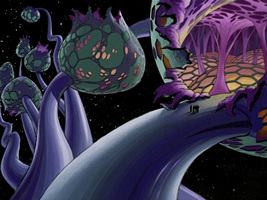
 "Beyond the Farthest Star"
"Beyond the Farthest Star"